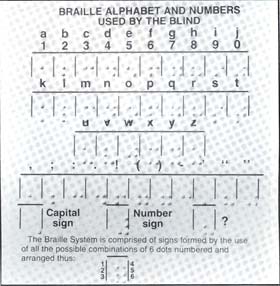
Courtesy of the National Federation of the Blind
 Courtesy of the National Federation of the Blind |
Two factors tend to inhibit blind and low vision individuals from leisure participation: transportation and lodging. With the recent passage of the Americans with Disability Act of 1990, the U.S. Architectural and Transportation Barriers Compliance Board is developing standards to improve disabled individuals' access and use of transportation vehicles and public accommodations. The proposed standards will help facilitate the travel and recreation needs of blind and low vision individuals, estimated to be 1.7 million by the American Council of the Blind (ACB). Among standards being considered for the blind:
Despite these efforts, recent studies reveal that the number of consumers literate in Braille and thus able to take advantage of the new federal standards when implemented may be far fewer than expected. The Braille illiteracy rate for blind and low vision individuals has increased significantly over the last 15 years (N.Y. Times, 5/12/91). Dr. Susan Spungin of the American Foundation for the Blind (AFB) explains that "there is a growing awareness and concern about the decrease in Braille reading and writing from both consumers using the Braille code and teachers capable of instructing students."
Although experts disagree as to why Braille lost status as a primary literacy tool, some of the major arguments are that:
Kenneth Jernigan of the National Federation of the Blind (NFB) proposes the passage of Braille bills at the state level to overcome illiteracy of blind persons. Jernigan intends to ask legislatures in all 50 states to require teachers of the blind to be competent in reading and writing Braille and to make instruction in Braille available to every blind and low vision student. In the last three years Braille bills have been passed in Kansas, Minnesota, Missouri, South Carolina, and Texas. Jernigan suggests that "all persons who have sight ought to be taught to use their sight let them learn print. But also provide the low vision individuals, especially those with progressive diseases, the opportunity to learn Braille so they can remain literate."
The importance of the old credo of not teaching a child both Braille and print has diminished. Dr. Spungin notes that "teaching two modes of accessing language should not be confusing or we should never teach foreign language in school."
The National Federation of the Blind's position for improving Braille competency among teachers is supported by both the AFB and ACB. However, both groups oppose the Federation's goal of lobbying state legislatures to unilaterally mandate the teaching ofBraille for every blind and low vision child in the U.S. Instead, the AFB and ACB support the intentof PL94-142 which requires the educational needs of children be addressed on an individual basis.
Currently, the U.S. Library of Congress is developing a certification program to assure that teachers of the blind are competent readers and writers of the Braille code. When the certification program is completed, teachers who seek state certification may have to pass a national exam equivalent to the stringent standards established for certified transcribers of Braille. In another development, the American Printing House of the Blind is developing an assessment tool for borderline cases, i.e., visual deficits which require the teaching of both Braille and print.
The culmination of these efforts will enable the functionally literate in Braille to use current state-of-the-art electronics such as the Braille 'n Speak and Versa Braille. Ultimately, the blind will read, write, and review Braille material more rapidly and efficiently than with the slate and stylus or the Perkins Brailler.
This resurgence of Braille is presenting a new challenge not only to teachers of the blind but to other professionals involved with the visually disabled. As teachers and therapists, do we understand the basic principles of the Braille code? Do we know the two grades of Braille and how they are taught? Are we familiar with the latest Braillecommunication aids and how they operate? Should we as professionals learn Braille sufficiently well to be role models for blind or low vision students?